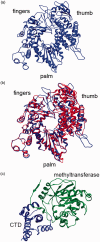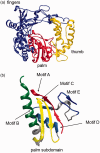Nucleosides for the treatment of respiratory RNA virus infections
- PMID: 29562753
- PMCID: PMC5890544
- DOI: 10.1177/2040206618764483
Nucleosides for the treatment of respiratory RNA virus infections
Abstract
Influenza virus, respiratory syncytial virus, human metapneumovirus, parainfluenza virus, coronaviruses, and rhinoviruses are among the most common viruses causing mild seasonal colds. These RNA viruses can also cause lower respiratory tract infections leading to bronchiolitis and pneumonia. Young children, the elderly, and patients with compromised cardiac, pulmonary, or immune systems are at greatest risk for serious disease associated with these RNA virus respiratory infections. In addition, swine and avian influenza viruses, together with severe acute respiratory syndrome-associated and Middle Eastern respiratory syndrome coronaviruses, represent significant pandemic threats to the general population. In this review, we describe the current medical need resulting from respiratory infections caused by RNA viruses, which justifies drug discovery efforts to identify new therapeutic agents. The RNA polymerase of respiratory viruses represents an attractive target for nucleoside and nucleotide analogs acting as inhibitors of RNA chain synthesis. Here, we present the molecular, biochemical, and structural fundamentals of the polymerase of the four major families of RNA respiratory viruses: Orthomyxoviridae, Pneumoviridae/Paramyxoviridae, Coronaviridae, and Picornaviridae. We summarize past and current efforts to develop nucleoside and nucleotide analogs as antiviral agents against respiratory virus infections. This includes molecules with very broad antiviral spectrum such as ribavirin and T-705 (favipiravir), and others targeting more specifically one or a few virus families. Recent advances in our understanding of the structure(s) and function(s) of respiratory virus polymerases will likely support the discovery and development of novel nucleoside analogs.
Keywords: RNA-dependent RNA polymerase; Respiratory syncytial virus; antiviral; coronavirus; influenza; nucleoside analog; picornavirus; rhinovirus.
Figures





Similar articles
-
Potential Broad-Spectrum Antiviral Agents: A Key Arsenal Against Newly Emerging and Reemerging Respiratory RNA Viruses.Int J Mol Sci. 2025 Feb 10;26(4):1481. doi: 10.3390/ijms26041481. Int J Mol Sci. 2025. PMID: 40003946 Free PMC article. Review.
-
The antiviral activity and mechanism of action of (S)-[3-hydroxy-2-(phosphonomethoxy)propyl] (HPMP) nucleosides.Antiviral Res. 2012 Nov;96(2):169-80. doi: 10.1016/j.antiviral.2012.08.010. Epub 2012 Sep 6. Antiviral Res. 2012. PMID: 22960154 Review.
-
The classification of viruses infecting the respiratory tract.Paediatr Respir Rev. 2003 Jun;4(2):84-90. doi: 10.1016/s1526-0542(03)00031-9. Paediatr Respir Rev. 2003. PMID: 12758044 Free PMC article. Review.
-
Antivirally active ribavirin analogues--4,5-disubstituted 1,2,3-triazole nucleosides: biological evaluation against certain respiratory viruses and computational modelling.Antivir Chem Chemother. 2014 Jan 29;23(4):161-71. doi: 10.3851/IMP2564. Antivir Chem Chemother. 2014. PMID: 23538746
-
Therapeutic targets in respiratory viral infections.Curr Med Chem. 2007;14(26):2776-82. doi: 10.2174/092986707782360132. Curr Med Chem. 2007. PMID: 18045123 Review.
Cited by
-
Omeprazole Increases the Efficacy of Acyclovir Against Herpes Simplex Virus Type 1 and 2.Front Microbiol. 2019 Dec 3;10:2790. doi: 10.3389/fmicb.2019.02790. eCollection 2019. Front Microbiol. 2019. PMID: 31849920 Free PMC article.
-
Antiviral and Antimicrobial Nucleoside Derivatives: Structural Features and Mechanisms of Action.Mol Biol. 2021;55(6):786-812. doi: 10.1134/S0026893321040105. Epub 2021 Dec 17. Mol Biol. 2021. PMID: 34955556 Free PMC article.
-
Viral infections in critical care: a narrative review.Anaesthesia. 2023 May;78(5):626-635. doi: 10.1111/anae.15946. Epub 2023 Jan 12. Anaesthesia. 2023. PMID: 36633460 Free PMC article. Review.
-
FDA approved drugs with pharmacotherapeutic potential for SARS-CoV-2 (COVID-19) therapy.Drug Resist Updat. 2020 Dec;53:100719. doi: 10.1016/j.drup.2020.100719. Epub 2020 Jul 15. Drug Resist Updat. 2020. PMID: 32717568 Free PMC article. Review.
-
Discovery, Development, and Patent Trends on Molnupiravir: A Prospective Oral Treatment for COVID-19.Molecules. 2021 Sep 24;26(19):5795. doi: 10.3390/molecules26195795. Molecules. 2021. PMID: 34641339 Free PMC article. Review.
References
Publication types
MeSH terms
Substances
LinkOut - more resources
Full Text Sources
Other Literature Sources
Miscellaneous

